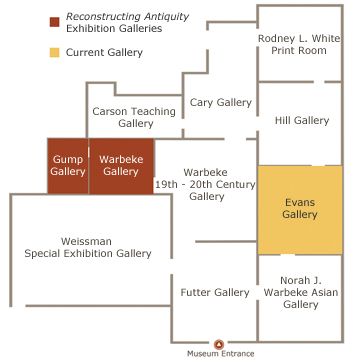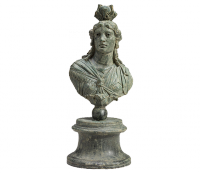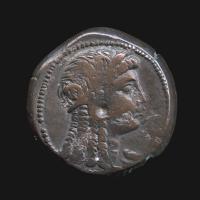Isis, Egyptian goddess of fertility worshipped in the Graeco-Roman world
Learn more about the object below
This bronze bust of the Egyptian goddess Isis dates to the high Roman empire (ca. 2nd century CE) when the popularity of her cult was at its zenith. The cult of Isis spread rapidly throughout the Mediterranean basin, supported at first by non-Romans, slaves, and women—those on the margins of society—as an alternative to the more staid Roman state religion from which they were largely excluded. The goddess is easily identified in this sculpture. She wears a uraeus (a headdress featuring a serpent), a traditional symbol of Egyptian royal power, and two ears of corn, symbols of fertility and abundance.
Isis was a principal character in the Osirian drama, a mythological saga that described her long voyage by sea in order to resurrect her brother-husband, Osiris, following his murder. Her ultimate goal was to ensure the survival of her own son, Horus. In its essentials, the Osirian drama was a myth of succession that appealed to Egyptian pharaohs as well as to the later Ptolemaic kings who ruled Egypt (305–30 BCE). Its influence on Cleopatra VII is indisputable; she famously appeared to Mark Antony for the first time (ca. 41 BCE) resplendent in a lavish barge, mirroring Isis’ dramatic maritime journey (Plutarch, Life of Antony, 26).
Cleopatra VII was one in a long line of Ptolemaic queens who identified closely with Isis, as this coin from the Mount Holyoke collection demonstrates. It bears the portrait of Cleopatra I, sister-wife of Ptolemy V Epiphanes (ca. 204–181 BCE), marked out by her characteristic braids covering the back of her neck. Ptolemaic dynasts practiced brother-sister marriage in order to preserve the purity of the royal bloodlines.
This coin from the Mount Holyoke collection depicts the royal pair, Cleopatra VII and Mark Antony, the Roman triumvir, with whom she had four children. In a grand ceremony (ca. 34 BCE) in Alexandria, Cleopatra conferred vast territories on these children and took on the title “New Isis” while seated on a golden throne on a silver stage, wearing a robe sacred to Isis (Plutarch, Life of Antony, 54). This ceremony established her children as future kings and queens, as the inscription of this coin apparently attests: “To the queen of kings who are the sons of kings.”
Label text by Geoffrey S. Sumi, Professor of Classics, Mount Holyoke College.





